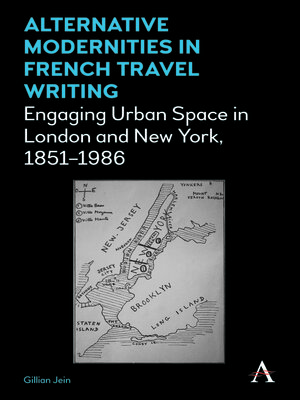Alternative Modernities in French Travel Writing
ebook ∣ Engaging Urban Space in London and New York, 1851–1986 · Anthem Studies In Travel
By Gillian Jein

Sign up to save your library
With an OverDrive account, you can save your favorite libraries for at-a-glance information about availability. Find out more about OverDrive accounts.
Find this title in Libby, the library reading app by OverDrive.



Search for a digital library with this title
Title found at these libraries:
| Library Name | Distance |
|---|---|
| Loading... |
Ever since human beings first travelled, cities have constituted important material and literary destinations. While the city has formed a key theme for scholars of literary fiction, travellers' writings on the western city have been somewhat neglected by travel studies. However, travel writing with its attention to difference provides a rich source for the study of representational strategies and tactics in modern urban space.
Beginning at the Crystal Palace in 1851 and ending up in the skyscrapers of NYC, this book analyses the writings of lesser-known as well as canonical French travel writers, including Paul Morand, Jean-Paul Sartre, Georges Perec and Jean Baudrillard. Tracing the work of these writers in London and New York from 1851 to the 1980s, it contributes to a body of work that analyses travel and travel writing beyond the Anglophone context, and engages in questions pertaining to the French imagination of possible meanings for life in the modern city. One of the central tenets of the book is that, in the way its spaces are planned, encountered and represented, the city is active in formulating identities, while the book's guiding question is how analysis of French travel writing allows us to explore the multiplicity of urban modernities by engaging with the historical and cultural differences internal to 'the West'.
Bringing together the strands of theory, context and poetic analysis, the book treats of travel writing as a spatial practice, one that engages representations of urban space in questions of nationality, power and legibility. In this way, it opens avenues for the exploration of urban modernity from a position of alterity, whereby alternative imaginative geographies of the city come into view.
|Ever since human beings first travelled, cities have constituted important material and literary destinations. While the city has formed a key theme for scholars of literary fiction, travellers' modes of writing the city have been somewhat neglected by travel studies. However, travel writing with its attention to difference provides a rich source for the study of representational 'strategies' and 'tactics' in the modern city. Tracing spatial practices of French travel writers in London and New York from1851 to the 1980s, this book contributes to a body of work that analyses travel and travel writing beyond the Anglophone context, and engages a variety of travel writing in questions surrounding French modalities for negotiating and establishing a nexus of meanings for life in the modern city. One of the central tenets of the book is that, in the way its spaces are planned, encountered and represented, the city is operational in the formulation of identities and ideologies, and the book's guiding question is how travel and travel writing allow for the exploration of urban modernity from a perspective of exchange. Bringing together the strands of theory, context and poetic analysis, this book examines travel writing as a spatial practice of the modern city, engaging urban space in questions of nationality, power and legibility and opening avenues for the exploration of urban modernity from a position of alterity, where alternative imaginative geographies of the city might emerge.







